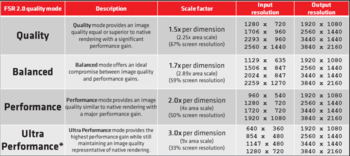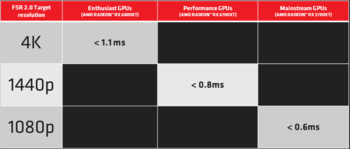AMD has updated the FSR 2.0 page on GPUOpen to include the latest details revealed at the GDC 2022 event, and it looks like Team Red’s next gen upscaling technology could become a viable alternative to Nvidia’s DLSS, especially considering the open-source nature and the ease of implementation.
With the migration to the temporal-based algorithms, AMD acknowledges that FSR 2.0 “will be more demanding on graphics cards than a spatial upscaling solution like FSR 1.0.” This means that the Quality preset that delivers image quality on par with native or even better will require GPUs released in the past few years. However, AMD also includes Balanced, Performance and Ultra Performance modes that should enable “a good upscaling experience on lower performing or older GPUs.”
Speaking of older GPUs, the open-source nature of the FSR 2.0 algorithm allows GPUs like Nvidia’s GTX 16 series or the GTX 1070 to benefit from the Quality mode, but only in 1080p. For an optimal 1440p Quality mode experience, AMD recommends at least a GTX 1080 or an RX Vega GPU, while Quality 4K is recommended for Radeon RX 5700 or RTX 2070 GPUs and above. AMD confirms that FSR 2.0 will also be enabled on the latest Xbox consoles, yet it did not specify an exact time frame for this.
Just like DLSS, FSR 2.0 will introduce a small amount of latency, but AMD does not expect higher than 2 ms added lag. 4K Quality mode on high-end GPUs is estimated to add around 1 ms, while on mid-range GPUs, 4K Performance lag could go up to 1.5 ms. Otherwise, all other modes and resolutions are estimated to add sub-1 ms lag.
When talking about implementation times, AMD states that games that already support DLSS 2.x could also support FSR 2.0 with under 3 days of tweaking. A few more days of work would be required for UE4/UE5 titles that are compatible with the FSR 2.0 plugin, and if a game title does not support decoupling display / render resolution or Motion Vectors, the FSR 2.0 implementation could take up to a month.
Team Red added more comparison images and a new video that shows the differences between native and FSR 2.0, where we can see that edges are smoother in FSR 2.0 Quality mode, but the sharpness of most textures is slightly softer compared to native. Apparently, this could be rectified with the implementation of a sharpness slider in the game settings. No specific framerate improvement targets have been provided for now, as the technology is still in beta.
























